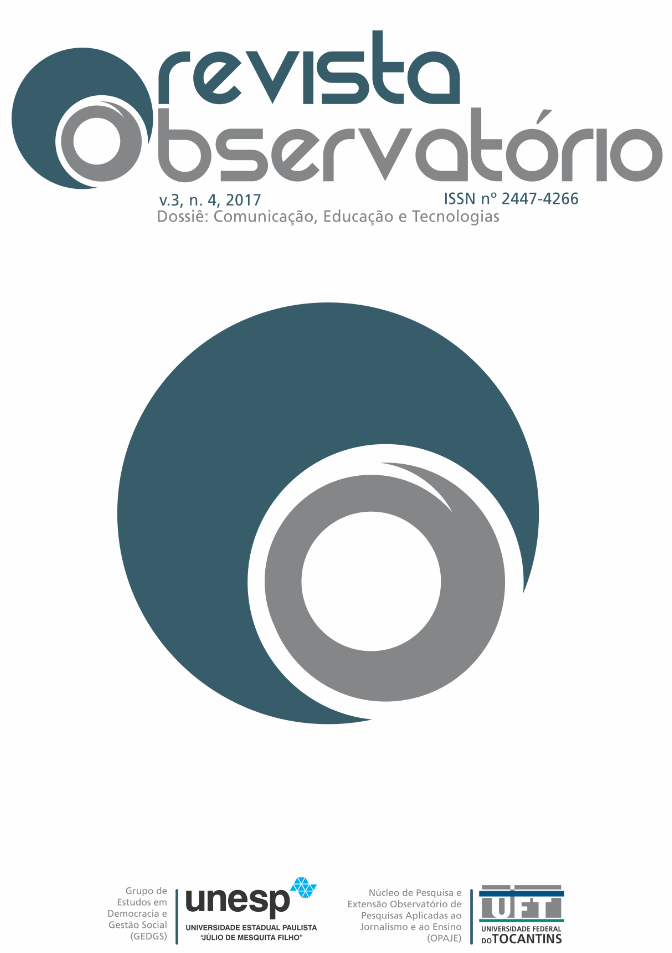THE INTERNET AS A LEARNING TOOL AND CULTURAL AND LINGUISTIC DIFFUSION FOR DEAF WOMEN
DOI:
https://doi.org/10.20873/uft.2447-4266.2017v3n4p407Keywords:
Deaf Women, LIBRAS, Technologies, AccessibilityAbstract
The article is based on the development of an ethnographic study considering a group of Deaf women and the use of Information and Communication Technologies (ICTs) as an agency to get information about women’s health. The technologies work as an instrument to search for understanding about their corporal health and their sexuality. In this process, we verified through social networks that the use of LIBRAS (Brazilian Sign Language) and the identification with the Deaf person are characterized in a positive way, as they oppose the view of disability. Finally, we demonstrated the importance of the use of technologies as an instrument of access to knowledge about health, which does not always is offered for Deaf women by health professionals.
Downloads
References
BASTOS, B.G.; FERRARI, D. V. Internet e educação ao paciente. Intl. Arch. Otorhinolaryngol., São Paulo - Brasil, v.15, n.4, p. 515-522, Out/Nov/Dezembro - 2011.
BRASIL. Lei nº 10.436 de 24 de abril de 2002, que dispõe sobre a Língua Brasileira de Sinais – LIBRAS, e dá outras providências. Publicada no Diário Oficial da União em de 24 de abril de 2002.
DURANTI, Alessandro. The scope of Linguistic Anthropology. In: Linguistic Anthropology. New York, NY: Cambridge University Press, 1997. ______(Org.). Linguistic Anthropology: A reader. Oxford: Blackwell Publish- ing Ltd, 2001.
______. (Org.). A Companion to Linguistic Anthropology. Malden, Mass.: Blackwell, 2004.
FREIRE, D. B. et al. Acesso de pessoas deficientes auditivas a serviços de saúde em cidade do Sul do Brasil. Cad. Saúde Pública, Rio de Janeiro, 25(4):889-897, abril, 2009.
GEDIEL, A. L. B. Saúde e Doença: os significados de família e reprodução das mulheres surdas de Porto Alegre, RS. In: Fazendo Gênero 9: Diásporas, diversidades, deslocamentos, 2010, Florianópolis. Anais Fazendo Gênero. Florianópolis: Fazendo Gênero 9, 2010. Disponível em:
<http://www.fazendogenero.ufsc.br/9/resources/anais/1277942265_ARQUIVO_TrabalhocompletoFazendoGenero.pdf>. Acesso em: 09:44hs.
GESSER, Audrei. LIBRAS? Que língua é essa? Crenças e preconceitos em torno da Língua de Sinais e da realidade Surda. São Paulo: Parábola Editora, 2009.
GIDDENS, Anthony. The Constitution of Society. Cambridge: Polity Press, 1984.
KOZINETS, R. V. On netnography: initial reflections on consumer research investigations of cyberculture. Advances in Consumer Research, New York, v. 25, p. 366-371, 1998.
LEININGER, M. M. Culture care diversity & universality: a theory of nursing. New York: National League for Nursing Press, 1991.
LÉVY, Pierre. As tecnologias da inteligência. Rio de Janeiro: Ed. 34, 1993.
LUPIÁÑEZ-VILLANUEVA, F. Health and the Internet: Beyond the Quality of Information. RevEspCardiol.2011;64:84950, 2011.
MERCADO. L.P.L. Pesquisa qualitativa online utilizando a etnografia virtual. Revista Teias v. 13 n. 30; 169-183 set./dez. 2012.
O’GRADY, L. Sensemaking and Credibility of Health Informationin Online Message Forums: A Multi-Method Study Assessing Tagging and Tag Clouds. CSCW 2010, February 6-10, 2010, Savannah, Georgia, USA.
PADDEN, C.; HUMPHRIES, T. Deaf in America - Voices from a culture.Cambridge: Harvard University Press, 1988.
PASSARELLI, B. O OBSERVATÓRIO DA CULTURA DIGITAL: A NOVA LINHA DE PESQUISA DA ESCOLA DO FUTURO DA USP. São Paulo, maio/2010.
QUADROS, Ronice M. de. & KARNOPP, Lodenir. Língua de Sinais Brasileira – Estudos Linguísticos. Porto Alegre: Artmed, 2004.
SILVA, M. F.; SILVA, M. J. P. A auto-estima e o não-verbal dos pacientes com queimaduras. RevEscEnferm USP 2004; 38(2):206-16.
STOKOE, William C. Sign Language Structure. Silver Spring: Linstok Press, 1960.
Downloads
Published
How to Cite
Issue
Section
License
[PT] Autores que publicam nesta revista concordam com os seguintes termos:
1. Autores mantém os direitos autorais e concedem à revista, sem pagamento, o direito de primeira publicação, com o trabalho simultaneamente licenciado sob a Creative Commons Attribution License (CC BY-NC 4.0), permitindo o compartilhamento do trabalho com reconhecimento da autoria do trabalho e publicação inicial nesta revista.
Leia todos os termos dos direitos autorais aqui.

